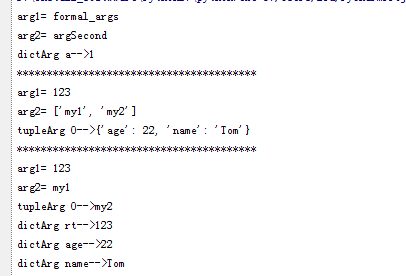Python中函数的参数传递与可变长参数介绍
1.Python中也有像C++一样的默认缺省函数
def foo(text,num=0):
print text,num
foo("asd") #asd 0
foo("def",100) #def 100
定义有默认参数的函数时,这些默认值参数 位置必须都在非默认值参数后面。
调用时提供默认值参数值时,使用提供的值,否则使用默认值。
2.Python可以根据参数名传参数
def foo(ip,port):
print "%s:%d" % (ip,port)
foo("192.168.1.0",3306) #192.168.1.0:3306
foo(port=8080,ip="127.0.0.1") #127.0.0.1:8080
第4行,没有指定参数名,按照顺序传参数。
第5行,指定参数名,可以按照参数名称传参数。
3.可变长度参数
#coding:utf-8 #设置python文件的编码为utf-8,这样就可以写入中文注释
def foo(arg1,*tupleArg,**dictArg):
print "arg1=",arg1 #formal_args
print "tupleArg=",tupleArg #()
print "dictArg=",dictArg #[]
foo("formal_args")
上面函数中的参数,tupleArg前面“*”表示这个参数是一个元组参数,从程序的输出可以看出,默认值为();dicrtArg前面有“**”表示这个字典参数(键值对参数)。可以把tupleArg、dictArg看成两个默认参数。多余的非关键字参数,函数调用时被放在元组参数tupleArg中;多余的关键字参数,函数调用时被放字典参数dictArg中。
下面是可变长参数的一些用法:
#coding:utf-8 #设置python文件的编码为utf-8,这样就可以写入中文注释
def foo(arg1,arg2="OK",*tupleArg,**dictArg):
print "arg1=",arg1
print "arg2=",arg2
for i,element in enumerate(tupleArg):
print "tupleArg %d-->%s" % (i,str(element))
for key in dictArg:
print "dictArg %s-->%s" %(key,dictArg[key])
myList=["my1","my2"]
myDict={"name":"Tom","age":22}
foo("formal_args",arg2="argSecond",a=1)
print "*"*40
foo(123,myList,myDict)
print "*"*40
foo(123,rt=123,*myList,**myDict)
输出为:

从上面的程序可以看出:
(1)如代码第16行。
参数中如果使用“*”元组参数或者“**”字典参数,这两种参数应该放在参数列表最后。并且“*”元组参数位于“**”字典参数之前。
关键字参数rt=123,因为函数foo(arg1,arg2="OK",*tupleArg,**dictArg)中没有rt参数,所以最后也归到字典参数中。
(2)如代码第14行。
元组对象前面如果不带“*”、字典对象如果前面不带“**”,则作为普通的对象传递参数。
多余的普通参数,在foo(123,myList,myDict)中,123赋给参数arg1,myList赋给参数arg2,多余的参数myDict默认为元组赋给myList。
 Merging Lists in Python: Choosing the Right MethodMay 14, 2025 am 12:11 AM
Merging Lists in Python: Choosing the Right MethodMay 14, 2025 am 12:11 AMTomergelistsinPython,youcanusethe operator,extendmethod,listcomprehension,oritertools.chain,eachwithspecificadvantages:1)The operatorissimplebutlessefficientforlargelists;2)extendismemory-efficientbutmodifiestheoriginallist;3)listcomprehensionoffersf
 How to concatenate two lists in python 3?May 14, 2025 am 12:09 AM
How to concatenate two lists in python 3?May 14, 2025 am 12:09 AMIn Python 3, two lists can be connected through a variety of methods: 1) Use operator, which is suitable for small lists, but is inefficient for large lists; 2) Use extend method, which is suitable for large lists, with high memory efficiency, but will modify the original list; 3) Use * operator, which is suitable for merging multiple lists, without modifying the original list; 4) Use itertools.chain, which is suitable for large data sets, with high memory efficiency.
 Python concatenate list stringsMay 14, 2025 am 12:08 AM
Python concatenate list stringsMay 14, 2025 am 12:08 AMUsing the join() method is the most efficient way to connect strings from lists in Python. 1) Use the join() method to be efficient and easy to read. 2) The cycle uses operators inefficiently for large lists. 3) The combination of list comprehension and join() is suitable for scenarios that require conversion. 4) The reduce() method is suitable for other types of reductions, but is inefficient for string concatenation. The complete sentence ends.
 Python execution, what is that?May 14, 2025 am 12:06 AM
Python execution, what is that?May 14, 2025 am 12:06 AMPythonexecutionistheprocessoftransformingPythoncodeintoexecutableinstructions.1)Theinterpreterreadsthecode,convertingitintobytecode,whichthePythonVirtualMachine(PVM)executes.2)TheGlobalInterpreterLock(GIL)managesthreadexecution,potentiallylimitingmul
 Python: what are the key featuresMay 14, 2025 am 12:02 AM
Python: what are the key featuresMay 14, 2025 am 12:02 AMKey features of Python include: 1. The syntax is concise and easy to understand, suitable for beginners; 2. Dynamic type system, improving development speed; 3. Rich standard library, supporting multiple tasks; 4. Strong community and ecosystem, providing extensive support; 5. Interpretation, suitable for scripting and rapid prototyping; 6. Multi-paradigm support, suitable for various programming styles.
 Python: compiler or Interpreter?May 13, 2025 am 12:10 AM
Python: compiler or Interpreter?May 13, 2025 am 12:10 AMPython is an interpreted language, but it also includes the compilation process. 1) Python code is first compiled into bytecode. 2) Bytecode is interpreted and executed by Python virtual machine. 3) This hybrid mechanism makes Python both flexible and efficient, but not as fast as a fully compiled language.
 Python For Loop vs While Loop: When to Use Which?May 13, 2025 am 12:07 AM
Python For Loop vs While Loop: When to Use Which?May 13, 2025 am 12:07 AMUseaforloopwheniteratingoverasequenceorforaspecificnumberoftimes;useawhileloopwhencontinuinguntilaconditionismet.Forloopsareidealforknownsequences,whilewhileloopssuitsituationswithundeterminediterations.
 Python loops: The most common errorsMay 13, 2025 am 12:07 AM
Python loops: The most common errorsMay 13, 2025 am 12:07 AMPythonloopscanleadtoerrorslikeinfiniteloops,modifyinglistsduringiteration,off-by-oneerrors,zero-indexingissues,andnestedloopinefficiencies.Toavoidthese:1)Use'i


Hot AI Tools

Undresser.AI Undress
AI-powered app for creating realistic nude photos

AI Clothes Remover
Online AI tool for removing clothes from photos.

Undress AI Tool
Undress images for free

Clothoff.io
AI clothes remover

Video Face Swap
Swap faces in any video effortlessly with our completely free AI face swap tool!

Hot Article

Hot Tools

SAP NetWeaver Server Adapter for Eclipse
Integrate Eclipse with SAP NetWeaver application server.

MinGW - Minimalist GNU for Windows
This project is in the process of being migrated to osdn.net/projects/mingw, you can continue to follow us there. MinGW: A native Windows port of the GNU Compiler Collection (GCC), freely distributable import libraries and header files for building native Windows applications; includes extensions to the MSVC runtime to support C99 functionality. All MinGW software can run on 64-bit Windows platforms.

Zend Studio 13.0.1
Powerful PHP integrated development environment

ZendStudio 13.5.1 Mac
Powerful PHP integrated development environment

mPDF
mPDF is a PHP library that can generate PDF files from UTF-8 encoded HTML. The original author, Ian Back, wrote mPDF to output PDF files "on the fly" from his website and handle different languages. It is slower than original scripts like HTML2FPDF and produces larger files when using Unicode fonts, but supports CSS styles etc. and has a lot of enhancements. Supports almost all languages, including RTL (Arabic and Hebrew) and CJK (Chinese, Japanese and Korean). Supports nested block-level elements (such as P, DIV),






